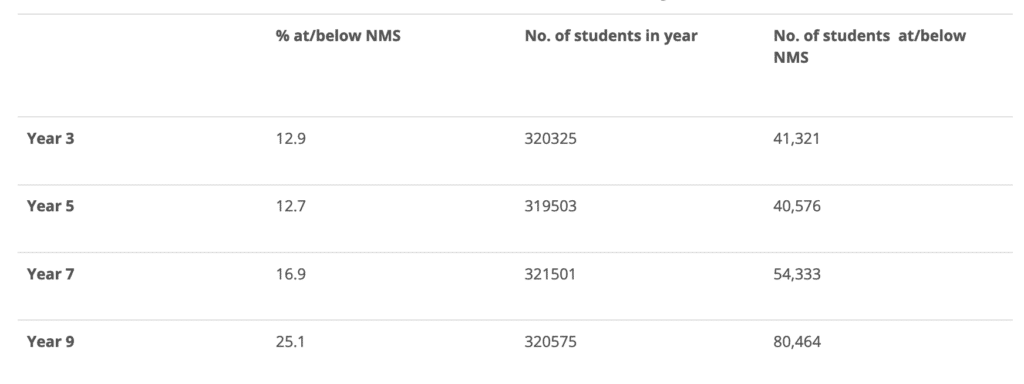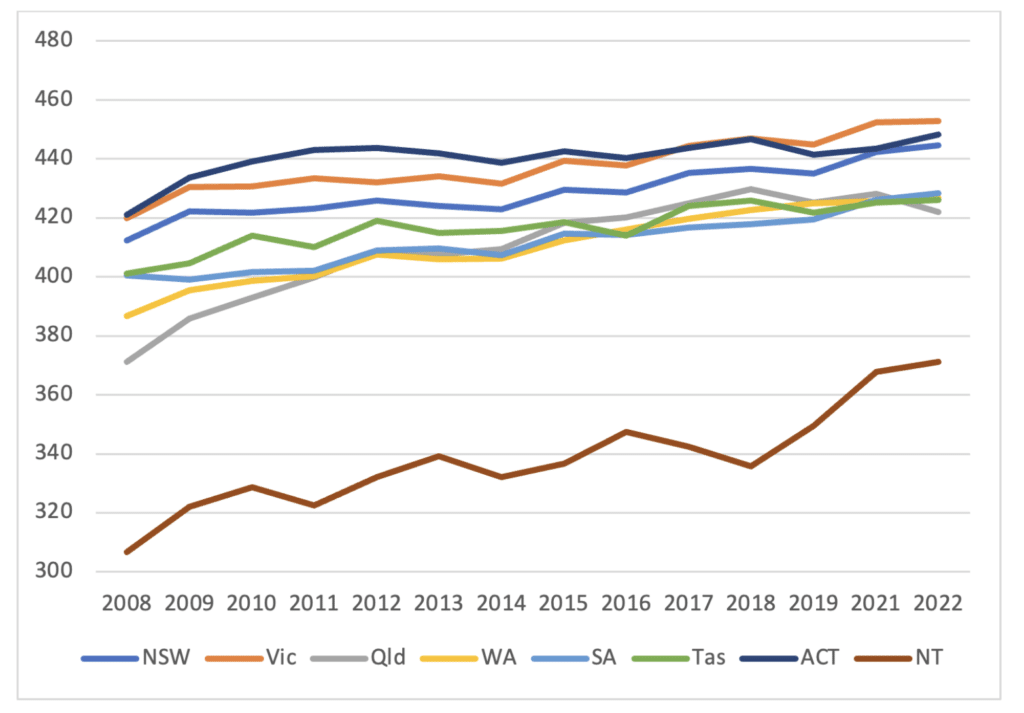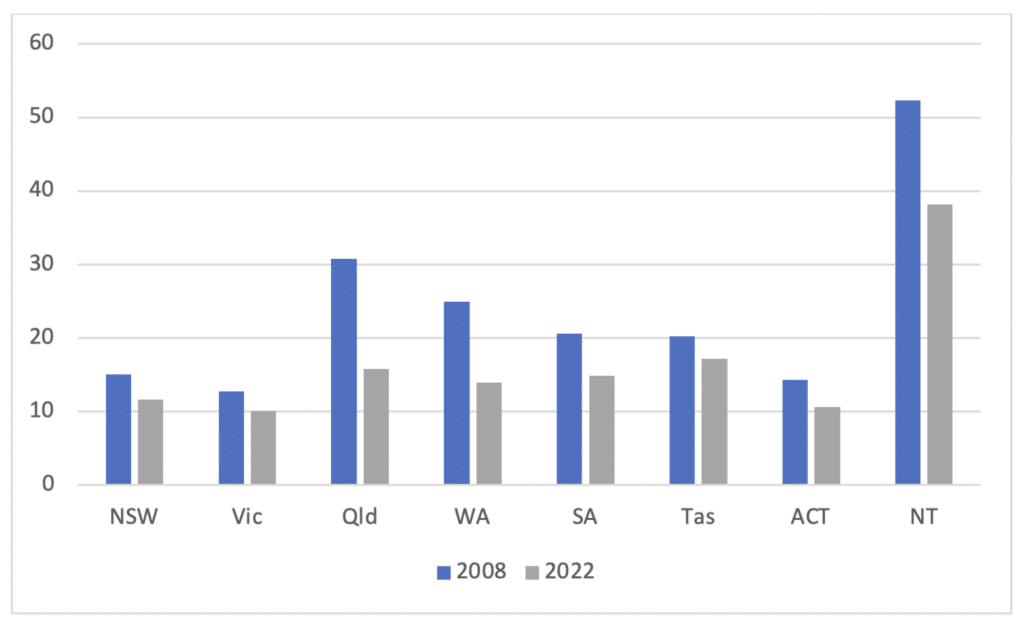
Teacher education reform: Where will all the experts come from?
Share this post Dr Jennifer Buckingham, 20 July 2023 The problems with education in Australia are not new. When the first major Commonwealth government report

In September, the Productivity Commission released an Interim Report from its Inquiry into the National School Reform Agreement (NSRA). The NSRA is “a joint agreement between the Commonwealth, states and territories to lift student outcomes across Australian schools. The NSRA outlines a set of strategic reforms in areas where national collaboration will have the greatest impact, builds on current national reform efforts, complements state and territory leadership and supports local implementation. Ongoing implementation of these shared commitments remains a condition of funding under the Australian Education Act 2013 (Cth) (Act).” (p. iv)
Below is my submission in response to the Interim Report, updated with statistics from NAPLAN 2022 which were released after I wrote my submission.
This submission addresses elements of two areas of focus identified in the Interim Report.
The goal of lifting outcomes for all students is surely the over-arching goal of any education reform initiative. Lifting outcomes in the fundamental skills of literacy and numeracy is essential. These skills underpin achievement in all other curriculum areas and are directly related to other aspects of school and post-school life, as described in the Interim Report.
The Productivity Commission’s Interim Report finding that a substantial number of students fail to meet minimum standards in literacy and numeracy each year was also identified in the Primary Reading Pledge report co-authored by Five from Five, AUSPELD, and Learning Difficulties Australia in 2020. The report makes the case for including students ‘at minimum standard’ among the students about which we should be concerned, because the minimum standard itself is very low. Students who are only ‘at’ the standard cannot be considered to be performing proficiently or competently in these areas.
Using the criteria of ‘at/below National Minimum Standard’ (NMS) gives a higher but still conservative number of students who are struggling with literacy and numeracy. It does not include students who were withdrawn or absent, many of whom would fall into this category if they had participated in the test. Table 1 provides estimates of the number of students who were at/below National Minimum Standard (NMS) in reading in 2022 using student population data from the Australian Bureau of Statistics. Approximately 54,000 students began their secondary schooling in 2022 with literacy levels that will make it difficult for them to succeed in education and training and in their lives beyond school. More than 80,000 students had low literacy in Year 9 in 2022.
Table 1. Students at/below National Minimum Standard (NMS) in NAPLAN Reading, 2022

Source: NAPLAN 2022 Interactive Report (ACARA); ABS Schools, Australia 2021 (Table 42b). Student numbers are from the year level below (eg., Year 3 in 2022 = Year 2 in 2021) because 2021 is the latest set of data from ABS.
The Productivity Commission’s Interim Report found that 80% of students who were below the NMS for numeracy in Year 3 in 2019 were either at (46%) or below (34%) the NMS in Year 5 in 2021. This means that the vast majority of students identified as struggling in NAPLAN tests in Year 3 did not receive the support they needed to make sufficient progress by Year 5 and were almost certainly still struggling with numeracy when they finished primary school.
With respect to literacy, the report states that “[a]round one-third of the students who do not meet minimum literacy standards in year 3 do not meet minimum standards in year 5”. It does not provide figures on the proportion of students below NMS in Year 3 that were at NMS in Year 5 for literacy, and the Productivity Commission declined to provide them on request. There is no reason to believe they are very different to those for numeracy and publication of the figures for literacy in subsequent reports would be welcome.
One of the most important findings in the interim report regarding student outcomes is that the majority of students with poor literacy and numeracy outcomes are not in one of the designated ‘priority equity cohorts’. This recognises formally, and perhaps for the first time quantitatively, that most struggling readers are ‘instructional casualties’ — students who could and should have learned to read but were not taught well. The implication is that if these students had received evidence-based classroom initial reading instruction in Foundation to Year 2, they would not be struggling readers in Year 3. (Moreover, this is also true of most struggling readers in the priority equity cohorts). On the upside, this problem can be fixed. A great deal is known about effective reading instruction. It needs to be brought into all classrooms so that fewer students need intervention.
The framework recommends a systemic standardised assessment in Year 1, ideally the Year 1 Phonics Screening Check, so that reading difficulties can be identified early and appropriate interventions can be provided to all students who require them. Reading difficulties in the early years are most often the result of low word reading accuracy and fluency. This can be identified with a well-designed phonics check to assess decoding ability. High quality phonics interventions are very effective, especially if provided at this critical stage in reading development (Gersten et al., 2020; Wanzek et al., 2018). Some Australian states have begun implementing the Year 1 Phonics Check, namely South Australia, New South Wales, and Tasmania. The Western Australian and Victorian governments have announced they adopting a different approach to phonics assessment. These are non-standardised approaches and are of unknown quality, unlike the Year 1 Phonics Check adopted from the UK used in the other three states which has strong technical expertise and reliability. Nonetheless, it is positive that the importance of assessing phonics knowledge in Year 1 has now been acknowledged in five out of eight states and territories.
Almost all students do the NAPLAN tests and they are an under-utilised resource for improvement. NAPLAN reading assessments are tests of comprehension. They indicate that students have low reading performance but not why. There are two fundamental aspects of reading that can typically explain a student’s low reading comprehension – word reading accuracy and language comprehension. That is, knowing what the words are, and knowing what they mean. This is the well-established ‘Simple View of Reading’ which is a highly robust and predictive model, with these two factors accounting for 95%+ of variance in reading ability (Gough & Tunmer, 1986; Hjetland et al., 2019; Sleeman et al., 2022).
The Primary Reading Pledge recommends that all students whose scores are at or below NMS in reading each year should be given screening assessments for phonic decoding (word reading accuracy) and language comprehension to determine which of these sub-skills requires support through intervention. The Primary Reading Pledge document provides lists of valid and reliable assessments and evidence-based interventions, many of which are free or low cost. Schools that provide high quality whole class initial reading instruction, identify struggling readers early, and intervene effectively see dramatic reductions in the number of students who need reading intervention in the upper primary years. This has positive consequences for students and for school resourcing. Examples of schools where this has occurred can be provided to the Productivity Commission on request.
The framework outlined in the Primary Reading Pledge would lend itself to a national policy initiative. It is based on the Response to Intervention model, which in turn is based on a ‘non-categorical’ approach to instruction, assessment and intervention. It is applicable at both a school and system level.
The Interim Report looks at NAPLAN scores in the past decade and finds that they have been ‘flat’. However, if we look back further, it can be noted that there have been improvements in NAPLAN reading performance in Year 3 and 5 over a period of time in which schools have been increasingly adopting evidence-based teaching methods in early reading instruction. The trend flattened from 2019 to 2022, presumably as a result of COVID-related interruptions to schooling.
Figure 1 shows mean scores for reading in Year 3. The NAPLAN National Report 2022 finds that the change from 2008 to 2022 is statistically significant and positive. Figure 2 shows the proportion of students at/below the NMS in 2008 and 2022. The proportions have reduced over this time (the large drop in Queensland is likely to be partly explained by the addition of a year of full time school). The scale of the change is not grand but it is progress to build on.
Figure 1. NAPLAN Year 3 Reading mean scores 2008–2022, by state and territory

Source: NAPLAN National Reports, various years (ACARA)
Figure 2. Percentage of students at/below National Minimum Standard in NAPLAN Year 3 Reading, 2008 & 2022, by state and territory

Source: NAPLAN National Reports, various years (ACARA)
With the exception of providers of initial teacher education (ITE), it is a widely held view that the quality of ITE in Australia is mostly unsatisfactory, especially for preparing teachers to teach reading. It is not necessary to describe the numerous reports and inquiries undertaken over several decades; they are well known. The lack of adequate improvement despite many reform efforts is spelled out in the latest review, ‘Next steps: Report of the Quality Initial Teacher Education Review’. The recommendations in that report seem to provide a feasible way forward but more could be done. It is disappointing that universities have to be forced through regulation to improve the scholarship and rigor of their course content, but they have persistently failed to do so voluntarily and indeed many Deans of Education and academics deny the need to do so.
Further evidence that there are gaps in teacher knowledge about effective, evidence-based reading instruction can be seen in the large numbers (many thousands) of teachers who spend their own time and often their own money to attend professional learning outside of school hours. The providers of this professional learning include the La Trobe University Science of Language and Reading (SOLAR) short courses, Edith Cowan University short courses, the Five from Five seminars and webinars, Think Forward Educators, AUSPELD, the state SPELD organisations, and Learning Difficulties Australia. In schools, organisations such as Fogarty EDvance, Teach Well, COGLearn and the Knowledge Society provide professional learning and coaching in high impact teaching strategies and the evidence that underpins them. All of these organisations are experiencing high demand as more and more teachers become aware of the gaps in their knowledge.
While ongoing professional learning and expertise development is a hallmark of a profession, much of this is essential knowledge that could and should have been taught to teachers in their degrees. Relying on teachers themselves and their schools to back-fill fundamental teaching skills post-graduation is enormously unproductive. As noted in the Interim Report, effective teachers by definition have better outcomes for students. Effective teachers use effective methods. When teachers do not obtain these skills either pre- or post-graduation, it is likely to be contributing to their workload, stress and potentially decisions to leave the profession.
Note: Quality Teaching Rounds is not a proven effective, evidence-based approach
The Interim Report puts forward Quality Teaching Rounds (QTR) as a potential approach to generating more effective teaching and therefore better student outcomes. QTR was also mentioned favourably in the ‘Next steps’ report. However, there is no research evidence that QTR has a positive impact on student outcomes when used by classroom teachers in schools, which is the measure by which the effectiveness of the approach should be judged.
The Quality Teaching Model/Rounds have been used in schools for about twenty years but until recently there had never been any experimental research that evaluated its impact on students’ academic outcomes. All of the research was on whether teachers got better at using the model, not whether students benefited as a consequence. Recently, however, a randomised control trial with student achievement as the outcome measure was conducted. The results for student achievement were weak at best when QTR was implemented by classroom teachers rather than the researchers themselves. This raises obvious questions about its value at scale in real school settings. Greg Ashman has also written about the research previously and has raised these concerns in his submission to the Productivity Commission. Given that the Quality Teaching Model does not currently have an empirical or scientific evidence base, and has not been updated in almost 20 years (the Framework/Classroom Practice Guide cited in the 2021 study was published in 2003 and contains no citations or references to support the model as being effective for learning), these weak research findings on QTR are not surprising. The Quality Teaching Model’s approach is at odds with pedagogies with good experimental evidence and is not informed by cognitive science. QTR should be investigated much more deeply before recommending its use more widely.
I would welcome the opportunity to speak with the Commissioners about this submission.
The views in this submission do not necessarily represent the views of my employer or any of the other institutions with which I am affiliated.

Share this post Dr Jennifer Buckingham, 20 July 2023 The problems with education in Australia are not new. When the first major Commonwealth government report

Share this post Dr Jennifer Buckingham, 23 June 2023 As greater consensus has been reached about how to teach children to decode and read words

Share this post Well before the sparkling new Australian Curriculum 9.0 endorsed replacing predictable texts with decodable texts in early years classrooms, demand had begun to grow

Want to drop us a line? You can get in touch by filling out the form below and we’ll get back to you as soon as possible!